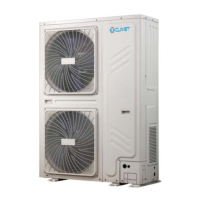Do you have a question about the CLIVET MSAN 81 and is the answer not in the manual?
Specific measures to prevent risks to persons and health hazards.
Optional components that can be fitted to the unit for enhanced functionality.
Information on the approximate shipping weight and packaging volume of the unit.
Specifies the operational temperature and pressure limits for cooling mode.
Guidelines for selecting the optimal location for unit installation.
Importance of adequate space for air circulation and correct unit operation.
Settings for safety devices like high/low pressure switches and fuses.
Data on sound power and pressure levels under specific operating conditions.
Steps to verify the unit's condition and completeness upon delivery.
Instructions for safe and proper handling of the unit using forklifts or similar equipment.
Detailed procedure for lifting the unit using a crane and appropriate safety measures.
Guidelines for storing the unit correctly to prevent damage or degradation.
Steps for safely unpacking the unit from its packaging materials.
Procedures for making necessary electrical connections before unit operation.
Specific instructions for connecting the unit to a 400/3/50 three-phase power supply.
How to connect and utilize the remote control module for system management.
Instructions for linking the unit to a PC or Building Management System for monitoring.
Essential checks to perform before initiating the unit's start-up sequence.
Steps for safely emptying the system, typically involving vacuum procedures.
Guidance on charging the system with the correct amount of refrigerant.
Procedure for adding oil to the compressor, related to refrigerant charge.
Critical checks to perform immediately after the unit's initial start-up.
How to verify and ensure the compressor is rotating in the correct direction.
Emphasis on monitoring compressor discharge temperature for proper operation.
How the main control module displays unit status and operating modes.
Explanation of compressor timer functions to prevent frequent starts/stops.
Detailed explanation of fan speed modulation for cooling operation.
How fan speed is managed during heating operation based on temperature.
How the defrost cycle is initiated and the steps involved.
How the defrost cycle concludes and the unit resumes normal operation.
Meaning of the LED indicators for compressor and defrost status.
Information on how operating parameters are accessed and managed.
Explains the function of each button on the control module.
Describes the menu structure and navigation within the control module.
Emphasizes that troubleshooting operations are the sole responsibility of the technician.
Troubleshooting steps for compressor cut-out events.
Diagnosis for fan overload issues.
Steps to identify and resolve noise issues with the unit.
Diagnostic steps when the compressor fails to start.
Cleaning and inspection procedures for the condenser coil.
Checks for fan condition, fastening, and balancing.
Inspection of the unit's structural components for damage or rust.
Checking the defrost water drainage system for proper function.
Inspection of power cables for damage and insulation integrity.
Details on suction and discharge piping for cooling and heating modes.
Information on liquid pipe connections and requirements.
Procedures for detecting refrigerant leaks in the system.
Specific guidance for correctly connecting inlet/outlet and liquid pipes.
Outlines the accessible and internal dangerous zones around the unit.
Safety information and diagrams related to refrigerants (Forane 407C, Forane 22).
Technical measures and advice for manipulating and storing the product.
Precautions and protective equipment for controlling exposure to the product.
Detailed physical and chemical properties of the refrigerants.
Information on product stability, reactivity, and conditions to avoid.
Toxicological data, health effects, and specific risks of the refrigerants.
Ecological impact, biodegradability, and potential environmental effects.
Guidance on the proper disposal methods for the product.
Shipping regulations and classification for the product.
Relevant EEC directives and safety classifications.
Recommended uses and bibliographical references for further information.












